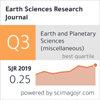Analysis of the influence characteristics and correction effect of the mine direct current method in advance detection of roadway cavities
IF 0.5
4区 地球科学
Q4 GEOSCIENCES, MULTIDISCIPLINARY
引用次数: 0
Abstract
To ensure safety during coal mining, the DC electric method is frequently used for the advanced detection of concealed water-rich abnormal geological bodies located ahead of a drivage roadway. However, to some extent, the accuracy of the detection is influenced by the roadway cavity, resulting in a deviation from the actual location of the anomaly. To investigate this phenomenon, the principle of advanced detection based on a spheroidal physical model was analyzed via “comparative analyses” and “simulated” methods using COSMOL Multiphysics software. Following the principle of numerical simulations, the influence of the roadway cavity on the accuracy of the advanced DC detection method was introduced, and the ratio of apparent resistivity calculated from actual data to that calculated only with the roadway cavity was carried out to obtain the roadway correction coefficient. This coefficient was employed to correct the apparent resistivity data for advanced 3-D detection. Additionally, the response characteristics of the anomalies at different electrode layout locations in the roadway were discussed. The results show that the ratio method effectively corrects the influence of the roadway during advance detection using the DC electric method and simultaneously improves the resolution of geological anomalies and the accuracy of positioning. Additionally, the influence of the roadway was related to the relative positions of the electrodes along the roadway. When the electrodes are set at the junction of the floor and the sidewall, the obtained resistivity curve is less affected. Therefore, the resolutions of the anomalies are higher, and their positioning is more accurate. Furthermore, a practical application of the ratio method indicated that the corrected curves reflected the geological anomalies better.矿井直流法超前探测巷道空腔的影响特征及校正效果分析
为保证煤矿开采安全,在超前探测巷道前方隐伏富水异常地质体时,常采用直流电法。但在一定程度上,探测精度受到巷道空腔的影响,与实际异常位置存在一定偏差。为了研究这一现象,利用COSMOL Multiphysics软件,通过“对比分析”和“模拟”两种方法,分析了基于球面物理模型的超前探测原理。根据数值模拟的原理,介绍了巷道空腔对先进直流探测方法精度的影响,利用实际数据计算的视电阻率与仅利用巷道空腔计算的视电阻率之比,得到巷道修正系数。利用该系数对视电阻率数据进行校正,实现超前三维探测。此外,还讨论了巷道中不同电极布置位置的异常响应特征。结果表明,比值法有效地纠正了直流电法超前探测时巷道的影响,同时提高了地质异常的分辨率和定位精度。此外,巷道的影响与电极沿巷道的相对位置有关。当电极设置在底板与侧壁交界处时,得到的电阻率曲线受影响较小。因此,异常的分辨率更高,定位也更准确。比值法的实际应用表明,校正后的曲线能更好地反映地质异常。
本文章由计算机程序翻译,如有差异,请以英文原文为准。
求助全文
约1分钟内获得全文
求助全文
来源期刊

Earth Sciences Research Journal
地学-地球科学综合
CiteScore
1.50
自引率
0.00%
发文量
0
审稿时长
>12 weeks
期刊介绍:
ESRJ publishes the results from technical and scientific research on various disciplines of Earth Sciences and its interactions with several engineering applications.
Works will only be considered if not previously published anywhere else. Manuscripts must contain information derived from scientific research projects or technical developments. The ideas expressed by publishing in ESRJ are the sole responsibility of the authors.
We gladly consider manuscripts in the following subject areas:
-Geophysics: Seismology, Seismic Prospecting, Gravimetric, Magnetic and Electrical methods.
-Geology: Volcanology, Tectonics, Neotectonics, Geomorphology, Geochemistry, Geothermal Energy, ---Glaciology, Ore Geology, Environmental Geology, Geological Hazards.
-Geodesy: Geodynamics, GPS measurements applied to geological and geophysical problems.
-Basic Sciences and Computer Science applied to Geology and Geophysics.
-Meteorology and Atmospheric Sciences.
-Oceanography.
-Planetary Sciences.
-Engineering: Earthquake Engineering and Seismology Engineering, Geological Engineering, Geotechnics.
 求助内容:
求助内容: 应助结果提醒方式:
应助结果提醒方式:


